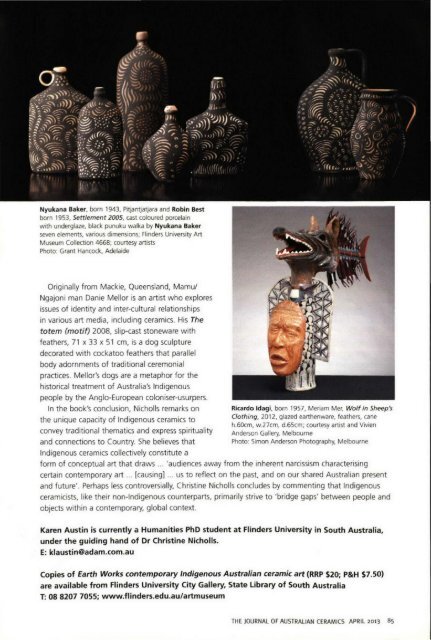The Journal of Australian Ceramics Vol 52 No 1 April 2013
You also want an ePaper? Increase the reach of your titles
YUMPU automatically turns print PDFs into web optimized ePapers that Google loves.
View<br />
art form. Many pots are decorated with panoramic landscapes and adorned with figurines that reflect<br />
matters <strong>of</strong> significance to artists. Irene Mbitjana Entata's (1946-) Babes (1996), synthetic polymer on<br />
terracotta, 15 x 11.3 x 10.8 cm, is an example. <strong>The</strong> pot is painted with a vivid rendition <strong>of</strong> Country. On<br />
its lid stand two bright pink pigs with curly tails. This work is both a testament to the many feral pigs<br />
that roam the region, as well as to Entata's delight in the 1995 hit <strong>Australian</strong> movie Babe.<br />
In 1966, under the auspices <strong>of</strong> the University <strong>of</strong> New South Wales, Pr<strong>of</strong>essor Leslie Haynes and others<br />
established a Ceramic Research Un it at the Bagot Road Aboriginal Settlement, Darwin. An Indigenous<br />
pottery venture was eventually established for commercial gains and as an outlet for artistic expression.<br />
Nicholls notes that this venture led to the establishment <strong>of</strong> the overwhelmingly male Tiwi Pottery,<br />
providing a foundation for the activity <strong>of</strong> many current-day ceramicists.<br />
With support from Catholic Missions, Tiwi Pottery was established in 1972. Well-known Tiwi<br />
narratives and traditions were <strong>of</strong>ten the basis for works. <strong>The</strong> earthenware sculpture l arakalani lantu<br />
(Turtle Boat) 1999, 56 x 80 x 32 cm, by Mark Puautjimi and Cyril James Kerinauia, is a depiction <strong>of</strong><br />
traditional turtle hunting. <strong>The</strong> work is painted with typical Tiwi geometriC patterns in red-brown, black<br />
and white that parallel designs on traditional barks and canvases.<br />
Nicholls asserts that no account <strong>of</strong> Indigenous ceramics could be complete without reference to<br />
Thanakupi, also known as Thancoupie (1937-2011). Thanakupi was a renowned, indeed inspirational,<br />
linguist, educator and ceramicist. Her works are displayed in fine arts institutions worldwide. She was<br />
the first Indigenous <strong>Australian</strong> to study fine arts at a tertiary level, to establish her own studio (1976),<br />
and to maintain a long, successful career as a ceramicist. In later works, Thanakupi <strong>of</strong>ten represented<br />
narratives associated with her Cape York Peninsula people. Spherical earthenware sculpture, Thaal the<br />
black eagle, Mal the red eagle, 1994, 29 x 32 cm, is representative, and has been incised with deep<br />
figurative and non-figurative patterns representing these sacred eagles.<br />
Nicholls's personal involvement in the (aborted) development <strong>of</strong> a modern ceramics tradition at<br />
Lajamanu (Tanami Desert) parallels her association with the community that she lived in as linguist,<br />
Thanakupi Gloria Fletcher, 1937-2011, Thaynakwith, Love magic pot, 1985, earthenware, salt glaze, h.9.8cm, w.13.Scm<br />
Flinders University Art Museum 2229; courtesy Jennifer Isaacs; photo: Flinders University An Museum

















